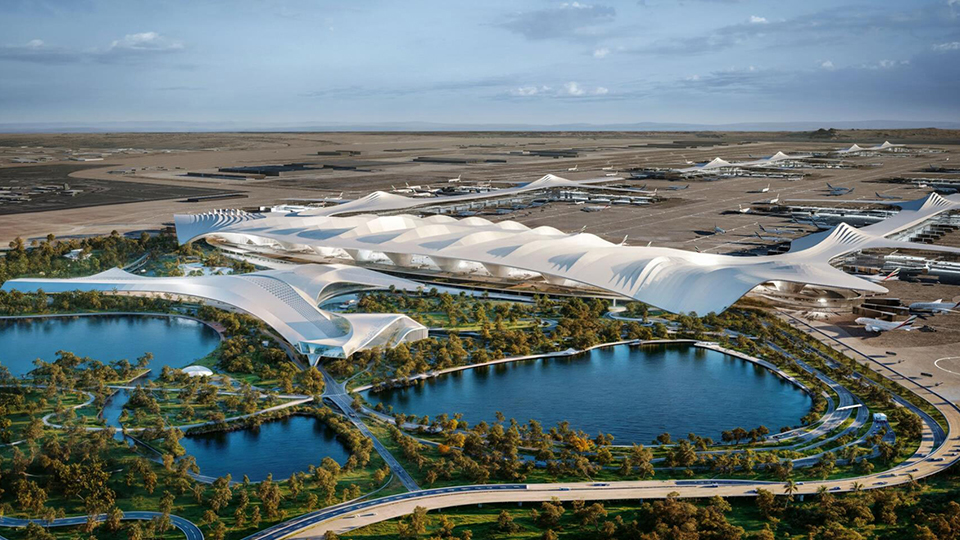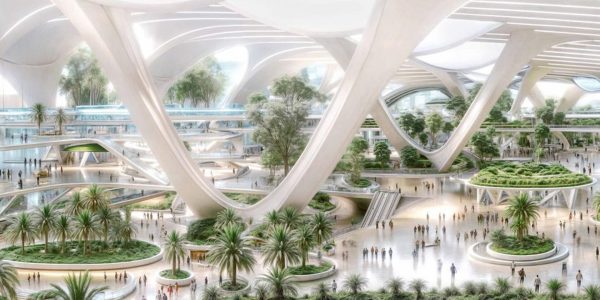
Dubai Set To Build World’s Largest Airport with 400 Gates and Five Runways
Construction of what will become one of the biggest airports in the world has been given the greenlight by rulers of the United Arab Emirates.
Mohammed bin Rashid approved designs on a new A$53 billion passenger terminal at Al Maktoum International Airport.
His Highness Sheikh Mohammed bin Rashid Al Maktoum, Vice President and Prime Minister of the UAE and Ruler of Dubai, reviewed the strategic plan of the Dubai Aviation Engineering Projects and approved designs for the new passenger terminal at Al Maktoum International Airport, which will be the largest in the world when fully operational.
Set to be built at a cost of AED$128 billion, the new terminal will ultimately enable the airport to handle a passenger capacity of 260 million annually.
“Today, we approved the designs for the new passenger terminal at Al Maktoum International Airport, and commencing construction of the building at a cost of AED 128 billion as part of Dubai Aviation Corporation’s strategy,” Sheikh Mohammed said.

“Al Maktoum International Airport will enjoy the world’s largest capacity, reaching up to 260 million passengers. It will be five times the size of the current Dubai International Airport, and all operations at Dubai International Airport will be transferred to it in the coming years.
“The airport will accommodate 400 aircraft gates and feature five parallel runways. New aviation technologies will be employed for the first time in the aviation sector,” His Highness said.
“As we build an entire city around the airport in Dubai South, demand for housing for a million people will follow. It will host the world’s leading companies in the logistics and air transport sectors,” His Highness added. “We are building a new project for future generations, ensuring continuous and stable development for our children and their children in turn. Dubai will be the world’s airport, its port, its urban hub, and its new global centre.”

Sheikh Mohammed reviewed the master plan for the Airport of the Future, which, upon full development, will emerge as the world’s largest airport, covering an expansive area of 70 square kilometres. The airport will have an ultimate capacity exceeding 260 million passengers and 12 million tonnes of cargo per annum.
During the event, His Highness Sheikh Mohammed was briefed on the key design features and strategic implementation plan for the airport.
“The new airport, which will ultimately be over five times the size of Dubai International, will prepare the ground for the next 40 years of anticipated growth in Dubai’s aviation sector. It will respond to the Hub Airline ambitious plans in terms of fleet acquisition and passenger growth,” Sheikh Mohammed said.
The airport will provide cutting-edge technologies, passenger facilities with unmatched level of service, and state-of-the-art aviation support facilities.
“Al Maktoum International (AMI) is planned in such a way as to represent a leap into the future.

“It will comprise of five parallel runways with a quadruple independent operation, west and east processing terminals, four satellite concourses with over 400 aircraft contact stands, uninterrupted automated people mover system for passengers, and an integrated landside transport hub for roads, Metro, and city air transport.
While embracing sustainability, Al Maktoum International will strongly contribute to mitigate environmental emissions, aligning with the UAE’s vision for a sustainably built environment. Its integrated approach is targeted to leverage local resources and climatic conditions achieving exemplary efficiency targets and sustainability goals. AMI aims to achieve a LEED Gold Certification.”
His Excellency Khalifa Al Zaffin, Executive Chairman of Dubai Aviation City Corporation, highlighted the economic benefits of the project. “The development of this new airport will be an integral part of Dubai’s economy and major contributor to the Dubai Economic Agenda (D33). It will generate estimated workforce and residential requirements for over a million people living and working in Dubai South (the aerotropolis), which has been under development and operation since 2007,” he said.
In a discussion on the sidelines, Her Excellency Suzanne Al Anani, CEO of Dubai Aviation Engineering Projects, said: “Dubai spearheads again. With the determination to maintain its leading role in the aviation sector globally, this airport development will represent a completely new approach to the concept of airports. The exponential acceleration of technologies and the abundance of knowledge in innovation will make us reinvent the passenger journey and experience.
“Connectivity and accessibility are also prioritised in coordination with our strategic partners, ensuring efficient public transportation links and a reduced reliance on private transport, which supports the reduction of the project’s carbon footprint.”
PUBLISHED ON: www.traveltalkmag.com.au


